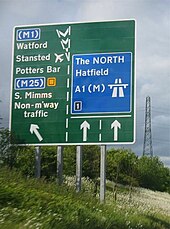Great North Road (Great Britain)

The Great North Road was the main highway between England and Scotland from medieval times until the 20th century. It became a coaching route used by
Route
The traditional start point for the Great North Road was Smithfield Market on the edge of the City of London. The initial stretch of the road was St John Street which begins on the boundary of the City (the site of the former West Smithfield Bars), and runs through north London. Less than a hundred metres up St John Street, into Clerkenwell, stood Hicks Hall, the first purpose-built sessions house for the Middlesex justices of the peace. The Hall was built in 1612, on an island site in the middle of St John Street (where St John's Lane branches to the west); this building was used as the initial datum point for mileages on the Great North Road (despite not being located at the very start of the road). Its site continued to be used for this purpose even after the building was demolished in 1782.[2]
In August 1599 during the performance of a puppet play in a house in St John Street the roof fell and killed five people.[3] The Red Bull Theatre was on St John Street between 1604 and 1666, when it was destroyed in the Great Fire of London.[4][5] James Burnett, Lord Monboddo (1714–1799) lived at 13 St John Street. He held "learned suppers" at his house, with guests including James Boswell, Robert Burns and Samuel Johnson.
The Great North Road followed St John Street to the junction at the Angel Inn where the local road name changes from St John Street to Islington High Street.

When the

At Alconbury, the Great North Road joined the Old North Road, an older route which followed the Roman
At Colsterworth the Great North Road diverges west of the Roman road and continues through
In the first era of
Cultural references
The
The Winchelsea Arms, an inn on a long straight section of the Great North Road near Stretton, Rutland, was reputed to be another haunt of Dick Turpin. It is now called the Ram Jam Inn after a story from the coaching days. A coach passenger undertook to show the landlady the secret of drawing both mild and bitter beer from the same barrel. Two holes were made and she was left with one thumb rammed against one and the other jammed into the other; the trickster then made off.[10]

In literature
In the oft-quoted first part of his essay England Your England, writer George Orwell refers to the "to-and-fro of the lorries on the Great North Road" as being a characteristic fragment of English life.
The road is mentioned in
See also
- The National Cycle Route 1
- The A1000, a main road in the United Kingdom, running north from Highgate, north London for approximately 20 miles to Welwyn, parts of which are on the route of the Great North Road and still bear the name.
- The A10 (in certain sections known as Great Cambridge Road or Old North Road) a main road in the United Kingdom, running north from London Bridge to King's Lynn.
References
- ^ Norman W. Webster (1974) The Great North Road
- ^ Norman Webster (1974) The Great North Road. Bath, Adams and Dart: 15–16
- ^ Sarah Williams, Letters of John Chambelain (London, 1861), p. 64
- Joseph Quincy Adams Jr. (1917). Shakespearean Playhouses: a History of English theatres from the Beginnings. The Riverside Press. p. 294. Retrieved 7 August 2011.
- ISBN 9781107041882.
- ^ Norman W. Webster (1974) The Great North Road: 22–23
- ^ "Relation: Great North Road". OpenStreetMap.
- ^ Norman W. Webster (1974) The Great North Road: 56-7
- ^ Norman W. Webster (1974) The Great North Road: 6–9
- ISBN 9780715327777
- ^ "The War of the Worlds, by H. G. Wells". www.gutenberg.org. Retrieved 21 March 2020.
- ^ "The Song Loch Lomond Bonnie Banks". Explorelochlomond.co.uk. Archived from the original on 4 March 2015. Retrieved 26 March 2018.
- ^ "Sting pays tribute to great north road's role in rock history". Daily Express. 11 October 2016. Retrieved 26 March 2018.
